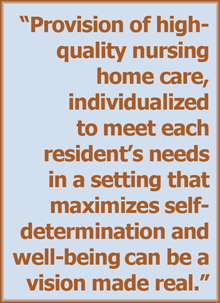 Background
Background
In the 1980s, consumer groups exposed substandard care in some U.S. nursing homes, as well as instances of even more dire problems like abuse and neglect. These revelations led the Institute of Medicine to issue a report recommending major regulatory changes and, in 1987, Congress passed a sweeping set of nursing home reforms that required facilities to provide individualized, or "person-centered," care. As a result, some providers began to move away from the institutional model of nursing home care and toward a more homelike environment in which residents could have a say in their day-to-day lives. In 1997, leaders in the industry formed the Pioneer Group to advocate for person-centered care and create a movement for "culture change" in the nation's nursing homes.
The Culture Change Movement
Proponents of culture change do not recommend a specific model or set of practices. Instead, they support principles governing resident care practices; organizational and human resource practices; and the design of the physical facility. According to these principles, an ideal culture change facility would feature:
- Resident direction. Residents should be offered choices and encouraged to make their own decision about personal issues like what to wear or when to go to bed.
- Homelike atmosphere. Practices and structures should be more homelike and less institutional. For instance, larger nursing units with 40 or more residents would be replaced with smaller "households" of 10 to 15 residents, residents would have access to refrigerators for snacks, and overhead public address systems would be eliminated.
- Close relationships. To foster strong bonds, the same nurse aides should always provide care to a resident.
- Staff empowerment. Staff should have the authority, and the necessary training, to respond on their own to residents’ needs. The use of care teams should also be encouraged.
- Collaborative decision-making. The traditional management hierarchy should be flattened, with frontline staff given the authority to make decisions regarding residents’ care.
- Quality improvement processes. Culture change should be treated as an ongoing process of overall performance improvement, not just as a superficial change or provision of amenities.
Encouraging Adoption of Culture Change
Despite widespread recognition of the movement, relatively few nursing homes have undertaken comprehensive culture change. However, according to a recent Commonwealth Fund survey of nursing homes, as many as one-third of facilities reported they had adopted some culture change practices, while another third said they planned to initiate some practices. To encourage the spread of culture change, policymakers should consider the following interventions:
- Direct engagement. Many states are using civil monetary penalty funds, as well as legislative funding, Medicaid dollars, and grants to spearhead culture change activities.
- Payment incentives. States can incorporate culture-change criteria into payment models to provide incentives to adopt person-centered care.
- Facility replacement. As nursing home structures age and become obsolete, policymakers can encourage design innovations by revising construction codes and creating tax credits to make capital costs more manageable.
- Regulatory approaches. Rhode Island’s survey agency developed a way to assess quality of life and residents’ rights, with the same degree of rigor as quality of care. This strategy could be used by regulators in other states.
- Public reporting and recognition programs. States can gather and report information on indicators like resident satisfaction, staffing, tenure of administrators, and use of per diem workers. Award programs can also work to motivate providers.
- Workforce enhancements. Labor and education departments can help policymakers improve entry-level training, revise licensing requirements to allow more flexible use of staff, and extend credentialing to nurses working in nursing homes.
- Research. Although there is a growing body of evidence on the efficacy of culture change, many questions remain. Policymakers can encourage and sponsor research and use results to promote person-centered nursing home care.
The Bottom Line
Culture change has shown promise in making care for nursing home residents truly person-centered. Policymakers can encourage culture change adoption through regulation, reimbursement, public reporting, and other mechanisms.


